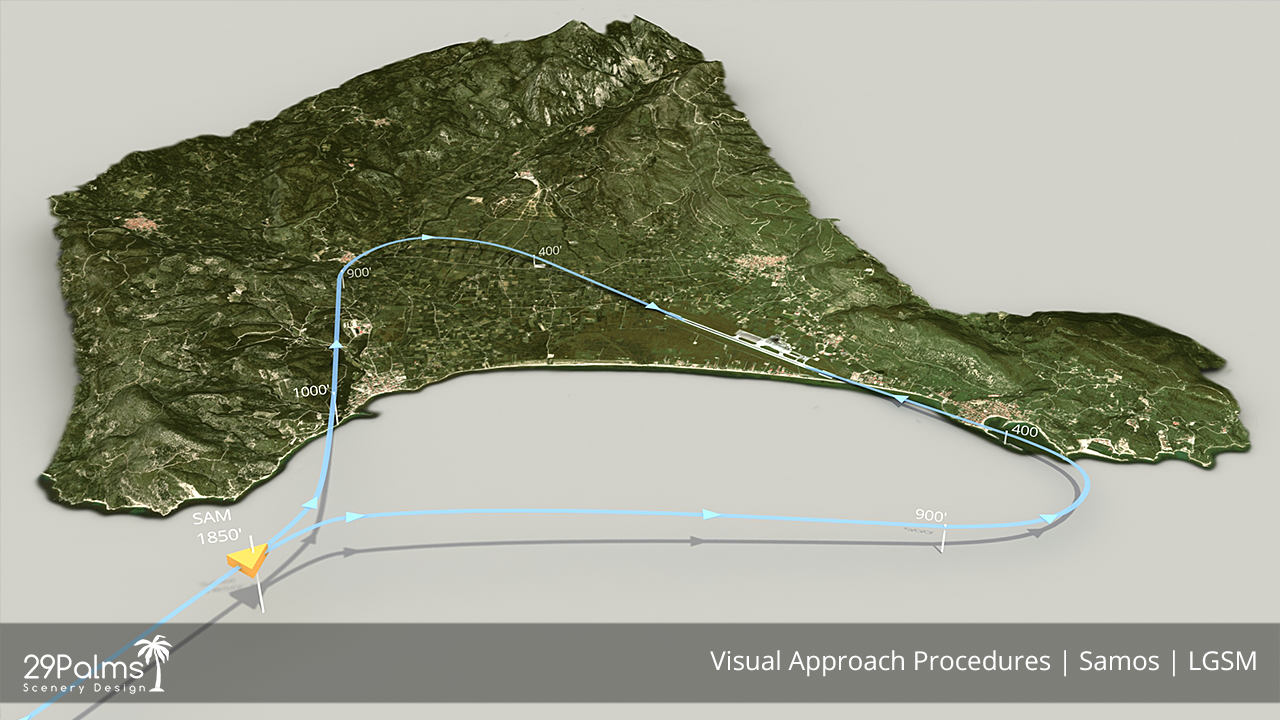29palms Scenery Manual wrote:4. Airport OperationsThe airport is situated in a basin by the sea surrounded by rising terrain close by in three quadrants with only one direction available for approach and departure, that being from the south. The eastwest oriented runway is at sea level, but 2,044m (6,706 ft) long. This is something which provides little room for error in the procedures explained below.
The usual wind prevails from northwest (310~340) and anything above 10kts generates turbulence and/or windshear on approach from surrounding terrain. Stronger winds always become gusty and a typical METAR of Samos with the summer "Meltemi" wind of Aegean Sea will display 33015G25KT. To complicate issues more there is a hill (Pythagoreion) just east of the airport north abeam of the final approach to runway 27. This hill generates prohibitive gusts and wind shear at lower levels in conditions anything above 10~15kts for aircraft who may be low and slow on approach runway 27. To complicate issues even more, just 4nm east of threshold 27 lies the coast of Turkey with steep rising barren terrain. This close proximity also means that Samos approach ATC can provide services only up to 2nm southeast from the runway with standard ICAO aircraft separation not guaranteed. There are often cases where “fast and low” flying aircraft “groups in formation” pass just 3nm south abeam the airport – typically outside Greece’s FIR border – without prior notice/coordination from neighboring ATC facilities. For more background on this read here:
https://en.wikipedia.org/wiki/Aegean_disputeSamos does not have approach radar and all ATC is based on procedural separation in relation to time above SAM VOR Initial Approach Fix (IAF) or DELOX IAF.
As IFR the airport is approached:
a) from the west via a DME ARC on SAM VOR using DELOX point as IAF
or
b) from above using SAM VOR as IAF with a teardrop procedure to the south
As VFR there are recommended VFR routes which you can see in the charts in the following folder:
“[FS main directory]/29Palms/29Palms – User Documents”LGSM – Samos
Below is a visualization of the final visual approach part of the IFR procedures.

This is a very useful page that briefs real pilots on the Samos procedures which includes even company made custom visual approach chart.:
https://pilotsbriefingroom.com/2011/09/ ... e-smilgsm/4.1. Approach Runway 09For the above reasons runway 09 is the preferred runway for landing even with tailwind gusts coming in from the rest of the mountains surrounding the airport. But even if it is the preferred runway, it too has a tricky approach due to terrain.
- A VOR approach is first executed that brings the aircraft heading north on R179 SAM perpendicular to the runway at 4 DME SAM to the South.
- Then, once visual with the area, SAM VOR is set to radial 240, the aircraft is steered northwest towards “Ireo” coastal village to fly just west abeam its pier which extends in to the sea crossing it at 1,100ft. They cross the coast at this point on a northwesterly heading, with 1,000ft high terrain just 1nm to the left
- They continue flying towards “Mili” the only next village, 1.7nm ahead, descending and heading straight for the 2,000ft high mountain!
- Descending for 900ft (500 AGL) pilots identify the big white agricultural shed in the valley below at “2 o’ clock” on extended centerline runway 09
- BEFORE they reach “Mili” village, while configured for final approach and landing (gear, flaps etc.), at radial 240 / 900ft AMSL they make the right turn to align with the white agricultural building (shed) and runway 09 having as a target to cross the shed at 400ft.
- At that point north-westerly quartering tail wind should also be anticipated for in the turn and if all works well the aircraft ends up properly aligned on runway 09 one nautical mile from touchdown!
The approach to runway 09 is explained nicely in these two videos in real aircraft:
https://youtu.be/poqxWx2tEL4 https://youtu.be/XXzPTE9pdCQand this one in the flight simulator by Matt "Belynz" Davies.
More interesting videos of Samos approach:
Until the 80's some airlines with "daring" pilots, especially with turboprop aircraft, used to execute a "straight in" approach to runway 09 from the west which included a considerable dive on short final phase after flying close to terrain in the west. This is (was) an even more dreadful approach! After the below mentioned accident and as rules got tighter in public transport flights, this approach was banned to airline crew from their companies as part of their SOP's. The worst air accident in Samos was in August 1989 and involved an aircraft which was on its way to execute just this approach.
The sad accident and outcome is documented here:
http://aviation-safety.net/database/rec ... 19890803-1Still nowadays, some military or private aircraft not under public transport category, do execute this approach at pilot's risk. The turbulence while flying low above terrain in the west in between the mountains is so strong though that these pilots execute it when wind strength is quite low i.e. less than 10 kts.
4.2. Approach Runway 27Aircraft approaching runway 27 on any day except winds calm conditions are very rare. The turbulence at low level on short final coming from Pythagorio hill abeam north is very dangerous. In days with calm winds when runway 27 is the pilot's choice aircraft leave SAM R179/D4.0 fix at 1850ft. with Pythagorio village to the northeast and its yacht marina pier in sight on a 040* heading descending for the visual approach. At this portion of the flight they fly within (less than) 3.5 DME SAM to remain inside Greece's airspace. South abeam the marina pier a left turn to line up with runway 27 is initiated with a target to cross abeam the pier at 400 ft. lined up with runway 27 at 1nm final.
A319 Approach 27
https://youtu.be/SFIA4rmDYbc /Pictures/Skyvector.png?raw=true)
